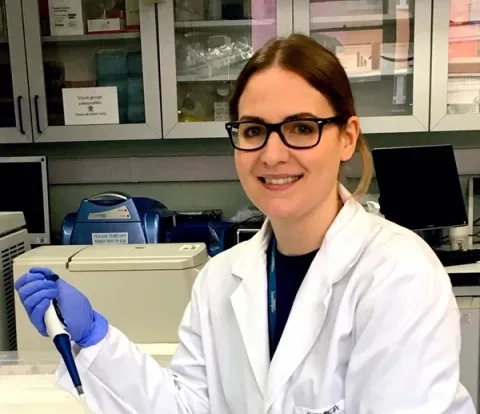Project overview
Vascular basement membranes (BMs) are specialised forms of the extracellular matrix (ECM) along which amyloid-beta (Aβ) drains from the brain as Intramural Periarterial Drainage (IPAD). Age-related changes to this BM impair IPAD, resulting in Aβ deposition in cerebral vessel walls in cerebral amyloid angiopathy (CAA), a major feature of Alzheimer’s disease (AD). Regulation of ECM turnover is performed by matrix metalloproteinases and their inhibitors, of which Tissue Inhibitor of Metalloproteinase 3 (TIMP-3) is the most significant. Increased levels of TIMP-3, accompanied by structural changes to the ECM, are observed with age and in age-associated neurodegenerative diseases, including AD, CAA and the retinal disease Age-Related Macular Degeneration (AMD), suggesting a key role of TIMP-3 in modifying disease risk in the brain and eye. In fact, patients with AMD have an increased risk of developing CAA, suggesting a shared underlying mechanism.
We hypothesise that cumulative oxidative damage over the life-course modifies TIMP3’s structure, causing it to accumulate extracellularly, initiating the widespread extracellular dysregulation observed in age-associated pathologies of the brain and retina. To test this hypothesis, we will use human brain tissues of different ages to determine how TIMP-3 levels change over the life-course, as well as utilise innovative in vitro ageing models, followed by molecular biology techniques, high resolution confocal microscopy and biophysical methods to interrogate the ageing effect on TIMP-3 biology and Aβ clearance.
My findings promise to highlight a new, shared molecular mechanism underlying neurodegenerative diseases of the brain and retina that can be targeted for novel therapeutics.
We hypothesise that cumulative oxidative damage over the life-course modifies TIMP3’s structure, causing it to accumulate extracellularly, initiating the widespread extracellular dysregulation observed in age-associated pathologies of the brain and retina. To test this hypothesis, we will use human brain tissues of different ages to determine how TIMP-3 levels change over the life-course, as well as utilise innovative in vitro ageing models, followed by molecular biology techniques, high resolution confocal microscopy and biophysical methods to interrogate the ageing effect on TIMP-3 biology and Aβ clearance.
My findings promise to highlight a new, shared molecular mechanism underlying neurodegenerative diseases of the brain and retina that can be targeted for novel therapeutics.

